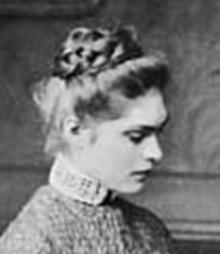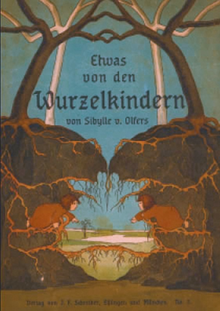Sibylle von Olfers
Maria Regina Hedwig Sibylla von Olfers (* May 8, 1881 in Metgethen Castle near Königsberg ; † January 29, 1916 in Lübeck ) was a German art teacher and religious sister who, as a children's book author and illustrator, created her best-known work Something from the Root Children in 1906 .
Life
childhood
Sibylle von Olfers was born as Maria Regina Hedwig Sibylla von Olfers on May 8, 1881 in Metgethen Castle, the mansion of the estate of the same name. The manor district was then part of the Königsberg district . She was the third of five children of the medical council , natural scientist and writer Dr. Ernst Friedrich Franz Gustav Werner Marie von Olfers and his second wife Olga Maria Bertha Freiin Behr. In the first marriage, her father was married to her mother's older sister and had four other children with her.
She grew up sheltered and, together with her siblings, enjoyed extensive education and instruction from governesses and tutors. The parents also had a particularly warm relationship with their numerous children. Sibylle was considered to be a “fine, intelligent girl who showed a passion for drawing at an early age and who differed from the other children with her fantastic games and ideas.” Despite her gentle Madonna face, her grandmother called her “a wild bumblebee” and wrote elsewhere "Sibyllchen would be prettier than ever and gifted, but she does not learn well in the first few years, she prefers to have fun in the lessons with her play fantasies."
Sibylle von Olfers had a particularly close relationship with her little sister, who was born a few years later, and whose life she made happy and fulfilled with original ideas and her artistic talents. Her picture books, specially designed for her sister, made the family happy.
Occasionally, however, Sibylle showed a quiet, childlike religiousness even in childhood, when she held devotions in front of her self-made altars, surrounded by numerous candles, modeled Madonnas or painted images of saints on the order of her sister.
artistic education
In the summer months her aunt Marie von Olfers came to visit Metgethen Castle. She lived as a writer, painter and salonnière in Berlin and taught Sibylle to draw and paint plants and animals. For hours, Sibylle von Olfers was hiding in a corner of the palace garden, trying to put part of nature on paper.
In the long run, however, her father Ernst von Olfers was unable to hold the Metgethen manor and so the extended family soon had to move to a cramped city apartment in Königsberg. At the age of seventeen, Sibylle von Olfers came to her aunt in Berlin, who continued to train her in drawing and painting. She also attended art classes with Julie Schultzen-Asten at the art school.
As a young woman, she was described as a graceful beauty who had numerous admirers and was welcomed at numerous social events. “She grew tall and slender. Golden blonde hair contrasted with jet black brows and long silk eyelashes that overshadowed large gray, glowing eyes. She was like one of those Botticelli Madonnas, her eyes generally lowered, a serious smile around her graceful mouth. But with all this apparent seriousness, she had a rogue on her neck, a rascal who gave her being a very special magic ”. She turned down a marriage proposal from a high, conservative nobleman with large estates, because she was alien to the “dazzling and elitist, useless world of the aristocrats” and she felt more drawn to the church.
Entry into the Order of the Gray Sisters of Saint Elizabeth
To the horror of her parents, she entered the order of the Gray Sisters of St. Elisabeth on May 21, 1906 in Königsberg , to which her sister, Nina, who was two years older, had been committed since 1900. She dropped her secular name and was now called Sister Maria Aloysia. After two years the order sent her as a school sister to a Catholic elementary school in Lübeck, where she taught all the subjects available there. In addition to her school activities, she also attended the art school of the history, landscape and genre painter Willibald Leo von Lütgendorff-Leinburg and mainly practiced copying old Italian masters. She painted her first altarpieces for the Herz Jesu parish church in Lübeck , some of which are still well preserved today. When she had finished a painting for the twelfth station of the Cross , a lung disease that had never been completely cured broke out again.
Lung ailments and death at the age of thirty-four
A long spa stay in the idyllic Gardone , which is on the west bank of Lake Garda , brought her illness to a temporary standstill. When the First World War broke out , she had to return to Lübeck early in the spring of 1915. For nine months she was able to go about her usual job until she forced her lung disease to go to the sick bed again on Christmas Day. She died after four weeks at the age of only 34. "Her death aroused participation far beyond Lübeck, the letters were innumerable which reflected the deep impression of her personality and deplored the early death of the pious religious and talented artist".
Her career as a children's book illustrator and author
In her first book Was Marilenchen erlebte a little girl learns about the realm of the snowflake children in a poetic way. It was published in 1905 and with it Sibylle von Olfers already achieved considerable success. Shortly thereafter, in 1906, her best-known work, Something from the Root Children, followed , which soon became a great success and developed into a classic among children's picture books. Another eight picture books followed, but none came close to the success of their root children .
meaning
What has been stimulating in Something from the Root Children to this day, “is the feeling of security of the children living in maternal earth, developing playfully, going their own way and finally returning home. This not only makes this Art Nouveau classic a showpiece for the analyst and his theses of detachment and self-discovery ... but also explains its continued popularity ”.
The artist also pursued something similar in her other children's picture books: nature is shown in a humanized form. The stories are mostly about the relationship between people, mostly children, and nature. This is symbolically represented by figures such as deer, rabbits, pixies or root children and is intended to make the processes in nature understandable for children. With her playful style, which is characterized by imaginative frame elements and artfully ornamentalized plants, Sibylle von Olfters claims a firm place in the art nouveau book art .
From today's perspective, Olfers' children's picture books shimmer through their sometimes antiquated educational ideas: “The sugar thief is threatened with a rod (shown three times on one side of the picture), whoever eats his soup well is rewarded with a curl in 'Butze Butze Bübchen' (1906 ); the animal, which behaves according to its nature and cannot be misused as a toy, is locked up for 'penance' and appeals to its 'sense of shame' - as in the roughly drawn 'hum-hum-bear' published posthumously in 1921 " .
Almost all of her works were published by the renowned children's and textbook publisher JF Schreiber, which has existed since 1851 .
Works
All works have been published by Esslinger Verlag (formerly Verlag JF Schreiber), Esslingen, and have been reissued again and again to this day.
- What Marilenchen experienced. 1905. (Reprint: ISBN 978-3-480-22073-1 )
- Something from the root children. 1906. (Reprint: ISBN 978-3-480-22512-5 ) ( digitized from an edition from 1918)
- Mummelchen and Chubby. A rabbit story in seven pictures. 1906. (Reprint: ISBN 978-3-480-07270-5 )
- Butze Butze Bübchen. 1906.
- Little princess in the forest. 1909. (Reprint: ISBN 978-3-480-06995-8 )
- Diaper. 1910. (Reprint: ISBN 978-3-480-22138-7 )
- King Lion's wedding feast. 1912, (Reprint: ISBN 3-215-07469-9 ) ( digitized version of the first edition 1912)
- Growl-growl-bear. 1912.
- In the butterfly kingdom. 1916.
Published posthumously :
- Animal kindergarten. 1952.
- The most beautiful stories from Sybille von Olfers. 2006. (Reprint: ISBN 3-480-22161-0 )
As an illustrator:
- In the butterfly kingdom. With verses by Albert Sixtus . 1935. (Reprint: Esslinger Verlag Schreiber (Esslinger Reprint), Esslingen 50s and 2004, ISBN 3-480-22003-7 )
In the Schreiber Museum in Esslingen am Neckar , several dioramas on the topic of root children can be seen.
swell
- ↑ see birth certificate No. 34/1881 of the Juditten registry office, viewed online at Ancestry.de on December 24, 2018
- ↑ a b c M. vd Leyen: Sibylle von Olfers. A memory. Berlin 1912. (private print);
- ^ W. Scherf: Olfers, Sibylle v. In: Historical Commission of the Bavarian Academy of Sciences (Hrsg.): New German Biography. Volume nineteenth, Berlin 1999, p. 521.
- ^ Ch. Oberfeld: Sibylle von Olfers. In: K. Doderer (ed.): Lexicon of children and youth literature. Second volume, Weinheim 1977, p. 610.
literature
- M. vd Leyen: Sibylle von Olfers. A memory. Berlin 1912. (private print)
- M. v. Olfers: Two sisters. Letters from a religious sister to her sister living in the world. Paderborn 1933.
- Ch. Oberfeld: Sibylle von Olfers. In: K. Doderer (ed.): Lexicon of children and youth literature. Second volume, Weinheim 1977, pp. 609-610.
- H. Herbst: Sibylle von Olfers: Something from the root children. In: The slate. H. 1, 1983, pp. 3-20.
- E. Schindler-Holzapfel: Oh, if it were always summer! In: Youth Literature. H. 3, 1984, pp. 17-19.
- M. Berger: Sibylle von Olfers. In: AC Baumgärtner, H. Pleticha (ed.): Children and youth literature. A lexicon. 4th result Lfg. 1997, pp. 1-12;
- Walter Scherf: Olfers, Sibylle von. In: New German Biography (NDB). Volume 19, Duncker & Humblot, Berlin 1999, ISBN 3-428-00200-8 , pp. 520 f. ( Digitized version ).
- Manfred Berger : OLFERS, Maria Regina Angela Hedwig Sibylla von. In: Biographisch-Bibliographisches Kirchenlexikon (BBKL). Volume 20, Bautz, Nordhausen 2002, ISBN 3-88309-091-3 , Sp. 1129-1133.
Web links
- Literature by and about Sibylle von Olfers in the catalog of the German National Library
- Works by and about Sibylle von Olfers in the German Digital Library
- Search for "Sibylle von Olfers" in the SPK digital portal of the Prussian Cultural Heritage Foundation
- Elven portal
- JF Schreiber publishing house in Esslingen
- In the butterfly kingdom at Project Gutenberg
| personal data | |
|---|---|
| SURNAME | Olfers, Sibylle von |
| ALTERNATIVE NAMES | Olfers, Sybille von; Orufasu, Jibyure fon |
| BRIEF DESCRIPTION | German children's book author, illustrator and writer |
| DATE OF BIRTH | May 8, 1881 |
| PLACE OF BIRTH | Metgethen Castle, Koenigsberg |
| DATE OF DEATH | January 29, 1916 |
| Place of death | Lübeck |

